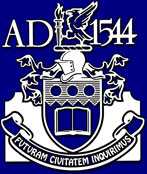The Prescot School: Difference between revisions
Prescotian (talk | contribs) |
Prescotian (talk | contribs) |
||
| Line 15: | Line 15: | ||
In [[1975]], it became part of the newly-formed [[Metropolitan borough|Metropolitan Borough]] of [[Metropolitan Borough of Knowsley|Knowsley]], and joined with Prescot Grammar School for Girls (founded [[1955]]) to become Prescot Comprehensive School. The school moved to the Girls' School site and the extensive playing fields of the Boys' School in St Helens Road were sold off and are now covered by a housing development. |
In [[1975]], it became part of the newly-formed [[Metropolitan borough|Metropolitan Borough]] of [[Metropolitan Borough of Knowsley|Knowsley]], and joined with Prescot Grammar School for Girls (founded [[1955]]) to become Prescot Comprehensive School. The school moved to the Girls' School site and the extensive playing fields of the Boys' School in St Helens Road were sold off and are now covered by a housing development. |
||
In 2000 Prescot School gained specialist status as a [[Language College]]. |
In 2000 Prescot School gained specialist status as a [[Language College]]. |
||
In 2000, The Prescotian webzine was set up to enable former pupils to keep in contact and establish an informal archive of photographs and articles. |
|||
==Merge== |
==Merge== |
||
Revision as of 12:52, 22 June 2008

Prescot School is co-educational comprehensive school in Prescot, Merseyside, England, and was previously called Prescot Grammar School.
The main historical source is local historian F.A.Bailey's 40 page pamphlet published to celebrate the 400th anniversary of the school in 1944 and reissued with postscripts by former heads G. Dixon and J.C.S. Weekes under the title PGS 1544 - 1971 in 1971.
History
The school was founded in 1544 by Gilbert Latham, a local clergyman who left £140 in his will to fund a schoolmaster (at a stipend of £7 per year) to run a free grammar school.
By 1944, when the Butler Education Act brought the school into the free national system, the school was in fact charging tuition fees. At this point, entry criteria passed from the ability to pay to the ability to pass the 11+ exam.
From the 1930s to the 1960s the school expanded under the control of headmaster R. Spencer Briggs to a peak of 650 boys. Briggs also modelled his school superficially on the British Public Schools with a prefect system, school uniform, and a heavy emphasis on games (particularly football and cricket). There was also rich extra-curricular activity (debating, amateur dramatics, choral and instrumental music, and a plethora of school societies. School rules included "traditional" idiosyncratic details such as that which required that the one or two women members of staff "be addressed as 'Sir' to avoid confusion". During this period the school applied for and was granted its coat of arms. The Latin motto Futuram civitatem inquirimus "We are seeking a future state" is from St; Paul and was quoted in the founder's will of 1544.
In 1975, it became part of the newly-formed Metropolitan Borough of Knowsley, and joined with Prescot Grammar School for Girls (founded 1955) to become Prescot Comprehensive School. The school moved to the Girls' School site and the extensive playing fields of the Boys' School in St Helens Road were sold off and are now covered by a housing development. In 2000 Prescot School gained specialist status as a Language College.
In 2000, The Prescotian webzine was set up to enable former pupils to keep in contact and establish an informal archive of photographs and articles.
Merge
With funding from the Labour government's Building Schools for the Future intitiative, the school will be rebuilt and will merge with Higher Side School in Whiston to become Prescot and Whiston Community Learning Centre.[1]
Notable alumni
- Stuart Sutcliffe, bassist for The Beatles for two years
- Sue Johnston, actress
- David McCabe, The Zutons lead singer
- John Waine, former Bishop of Chelmsford
- Alan A'Court, England and Liverpool FC footballer
- Geoff Nulty, Everton FC footballer
- Professor Sid Watkins, Safety supremo for Formula One Grand Prix motor racing
- Stan Hey, Playwright and journalist
- Paul Lewis, Classical pianist,soloist at the 2005 Last Night of the Proms
- Colin Vearncombe, Singer songwriter formerly known as the artist Black
- Laurence Perkins, Principal Bassoonist in Manchester Camerata
- Tony Hazzard, Songwriter, session singer and recording artiste
- John David Pugh, Member of Parliament for Southport
- Nicholas Fazakerley, Celebrated lawyer and MP for Preston in the years 1732-1767
- Gill Burns, former English Ladies Rugby Captain
- Ken Wilcock, Athlete and 1962 European Championships silver medallist
References
- ^ "Building schools for the future - schools involved". Retrieved 2007-03-05.
